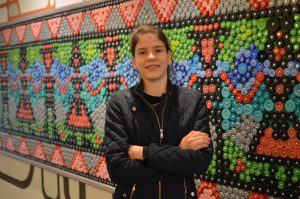By Drake Hills
Medill Reports
MADRID — More than 14 million people in the United States watched this year’s FIFA Women’s World Cup final in France, beating the total for the men’s World Cup final one year ago and the previous Women’s World Cup title match in 2015. As the growth of country participants and its viewers continue, so may the total number of women capturing its moments.
USA Today, ESPN, The Athletic and the Los Angeles Times were just some of the media outlets represented by women covering the World Cup. Nancy Armour, Alyssa Roenigk, Meg Linehan and Helene Elliott, respectively, proved that women are emerging in sports press boxes around the globe.
Just a week before the tournament began, a series of youth soccer events were held at the Dehesa de Navalcarbón Sports Complex, found in the western limits of the Spanish capital. Nearly 100 12-year-olds representing 57 nations sported their ocean blue, green and white Football for Friendship jerseys, blending in as one soccer contingent. On the sideline closest to the stands were youth journalist participants. Since the Football for Friendship’s birth in 2013, a growing number of those aspiring storytellers have been girls.
From a youthful Football for Friendship event to FIFA’s biggest tournament, a pathway for young girls has come into view.
The International Children’s Social Program- Football for Friendship was founded by Gazprom, a Russian global energy company that has administered a series of global youth soccer events each spring since its official partnership with the Union of European Football Associations (UEFA), began during the 2012-13 season.
Gazprom sponsors aspiring journalists from around the world to participate in the Football for Friendship events, covering the program’s soccer tournament. Both young athletes and journalists are provided the opportunity to mimic covering the UEFA Champions League final as players and media.
During this year’s Football for Friendship program, 28 young journalists covered the summer function. Seven were girls.
Event organizers said that the number of girls participating in the youth journalism program has fluctuated due to the varying total number of aspiring journalists each year.
Football for Friendship was built on nine pillars, two have directly supported the growth of young girls in the program: fairness and equality. Football for Friendship has the ability to inform and inspire young girls that may have otherwise believed becoming a soccer journalist was a career reserved for their male counterparts.
And for professionals like Paula Vilaplana, the program is that and more.
The Euronews television anchor and host roamed the field’s sidelines, reporting on the record-breaking assembly of soccer players when she noticed the young girls doing the same — an occurrence that Vilaplana had not seen at previous Football for Friendship events.
“My first edition of Football for Friendship was in Milan three years ago. There were no girls, just boys,” Vilaplana said. “The football participants were youth teams from professional clubs like Real Madrid, [Barcelona], Juventus, [Internazionale] Milan—they were there for them.”
Vilaplana was surprised by what she saw three yeas later. However, the Barcelona native also anticipated the female youth journalist representation, which would soon mirror the stories of current women in soccer media at the World Cup and beyond. Not to mention, it mirroring her own story.
“It’s natural because we have seen the media giving more opportunity towards [women] and it’s positive that Football for Friendship encourages them to be here,” Vilaplana said. “Sometimes, at the beginning of my career, I felt shy, or that I was nobody compared to [other journalists]. But if this is your passion and you’re good at it, it doesn’t matter if you are a boy or a girl.
“Euronews chose me, not because I am a girl, but because I am good at it and can do [my job] as good as a boy can.”
Despite the youth female journalists being the minority at the Football for Friendship events, their sheer passion for the game did anything but separate them from the young boys.
One of those girls was Smaranda Miron Tinca, a 12-year-old book fanatic from Bucharest, Romania. Standing slightly taller than her peers, Miron Tinca writes equally as well as she plays the game, inspired by her favorite player, Italian goalkeeper Gianluigi Buffon.
Tinca said her passion for long-form writing and soccer helped her fit in during her time in Madrid and meeting other girls with similar passions affirmed her desire to become a sports journalist.

“I think it had some impact on me because we met women who are [professional] journalists,” Tinca said after the record-breaking training session. “They came and gave us tips. They taught us how to make video blogs, what to record and learning about audio. We also learned tips about writing.”
The young girls and boys, collectively, were not just interviewing fellow pre-teens, but were given the chance to talk to world soccer legends like former Brazilian defender and Real Madrid maestro Roberto Carlos.
But for 12-year-old North Macedonian Kalina Vasilevska, becoming a soccer journalist is more than landing an interview with a world-class player. Vasilevska simply loves making an impact on her peers.
“I love journalism because it’s fun—the interviews, the writing and you express your feelings about what is going on,” Vasilevska said. “Football for Friendship is a program where you meet new friends from other countries and continents. That’s why I came here.”
For Miron Tinca and Vasilevska, working toward a spot in the professional sports media industry was influenced by their Madrid experience. Vilaplana said that it will set the girls up for a brighter future.
“For me, [Football For Friendship] would have helped me build confidence. When you’re young and live in a society that has told you that it’s not for you, but for the boys, you feel less than the others,” Vilaplana said. “It would have changed my mind to think that the opportunities are for me just as they are for the boys.”

